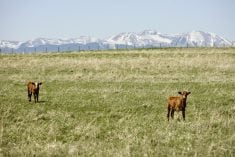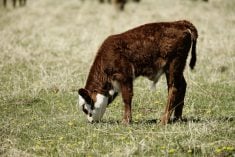Pregnancy checking remains one of the most underutilized management tools in the cow-calf business. Overlooking the chance to gather herd information as cows come off pasture in the fall is a missed opportunity for the cow-calf producer. A trip through the chute in fall should be much more than determining which cows to keep and which ones to cull based on their pregnancy status. There is a story to tell in every herd by gathering and analyzing fairly fundamental information gathered chute-side. Your veterinarian can be a big help in doing this. To make matters easier, there are simple applications, now downloadable onto cell phones, that cipher information as it is entered. As the last cow leaves the chute, the veterinarian and rancher can tally the scorecard over pizza and coffee.
Read Also

Body condition, nutrition and vaccination for brood cows
One of the remarkable events of the past century related to ranching has been the genetic evolution of brood cows….
- More Vet Advice: Ticks join new world order in infectious disease
On average, less than 20 per cent of producers routinely preg-check cows after grazing season. The figure climbs to 70 per cent for herds over 200 head, representing roughly 60 per cent of the cow herd (U.S. figures). Raw economics makes it hard to dispute whether pregnancy checking pays. It’s when an open cow eats $400 to $500 worth of winter feed (based on feed supply) will go back out to pasture and consume $150 worth of grass that should have gone to a cow nursing a calf to accrue $600 to $700 of cost for the year without contributing to the bottom line.
Handling cows through a chute in the fall is an opportunity to check for the nine main reasons cows are culled:
- Age or bad teeth
- Pregnancy status (open or aborted)
- Temperament
- Other reproductive problems
- Economics (drought, herd reduction, market conditions)
- Producing poor calves
- Physical unsoundness
- Udder problems
- Bad eyes
Total body energy reserves have a great impact on overall reproductive performance. Most importantly, if cows are thin at calving, reproductive performance in the subsequent breeding season will suffer. Maintaining a 365-day calving interval, requires maintaining cows at a BCS of 2.5 to three (Canada). Anything less and you lose ground. In that fifty per cent of fetal growth occurs during the last 60 days of pregnancy, inadequate protein and/or energy intake by the dam during this period is a primary cause of poor calf health. The lack of protein during the last trimester of pregnancy has been proven to be the primary predisposing factor for weak calves at birth. Cows need to be either maintaining or gaining BCS the last 60 days of pregnancy. If they’re going backward, the potential calf health is diminished.
In September 2016, Kansas State Diagnostic and Analytical Services released a new mobile app developed by Kansas State University’s Beef Cattle Institute. Pregnancy Analytics allows producers and veterinarians to manage pregnancy diagnosis information better. Designed to serve as an instant data collection and analysis tool, the app will facilitate the transformation of data into actionable information for individual herds.
The app accepts information like:
- Pasture ID/herd name
- Breed
- Cow ID
- Age
- Body condition score
- Number of days bred
From this information, projected calving dates are generated and graphs created to display the distribution of the producer’s next calving season.
Another useful app is South Dakota State University’s Extension Beef Management and Reproduction Score Card.
Basic information at preg-checking time allows:
- Earlier identification of open females.
- Better management of opens and culls — should open/cull cows be sold right away or is their profit in feeding them until higher prices return in the spring (March – April).
- Plan calving and pre-vaccination protocols and labour needs.
- Value-added marketing: Utilize pregnancy results to strategically market cows/calves. Examples: sell bred females by calving date, sell ET, AI, or gender-specific pregnancies.
- Set herd goals: By days 21, 42 and 63 of the breeding season (three cycles) have 61, 85 and 94 per cent of cows bred, respectively. By day 30 of the calving season, have 70 per cent of cows calved.
- Herd management: Pregnancy detection is one of the best investments one can make for the cow herd as it allows cow-calf producers to increase reproductive efficiency and profitability of their operation. By knowing the overall season pregnancy rate, they can identity where problems might have occurred during the breeding season and discuss these issues with their herd veterinarian. By identifying early calving cows, a more profitable herd can be designed as heifer calves born earlier in the season have greater pregnancy rates and longevity in the herd (Funston et al., 2011). In addition, steer progeny also benefit from being born during the first 21 days. Opens, culls and late-calving cows are best removed from the herd as a starting point to save forage if dry conditions continue through the fall.
- Pregnancy rate (percentage): Pregnancy checking can determine the overall fertility of the cow herd. If pregnancy rate is lower than desired, areas such as type of breeding program and bull-to-cow ratio should be analyzed to pinpoint where adjustments are needed. Also, evaluate pregnancy rates by sorting cows into age groups to see if a certain age group is falling out of the herd, such as two-year-olds or old cows.
- Pregnancy distribution (number of cows that became pregnant during days 1-21 of the breeding season, days 22-42, days 43-63, days 64-84, and 85 or more days after the start of the breeding season): Analyzing pregnancy distribution can be used as a guide to prepare for the calving season. Not only can the barn be ready by the time the first calf hits the ground, but you can also determine when the majority of the calves will be born, and adjust labour and feed resources accordingly.

















